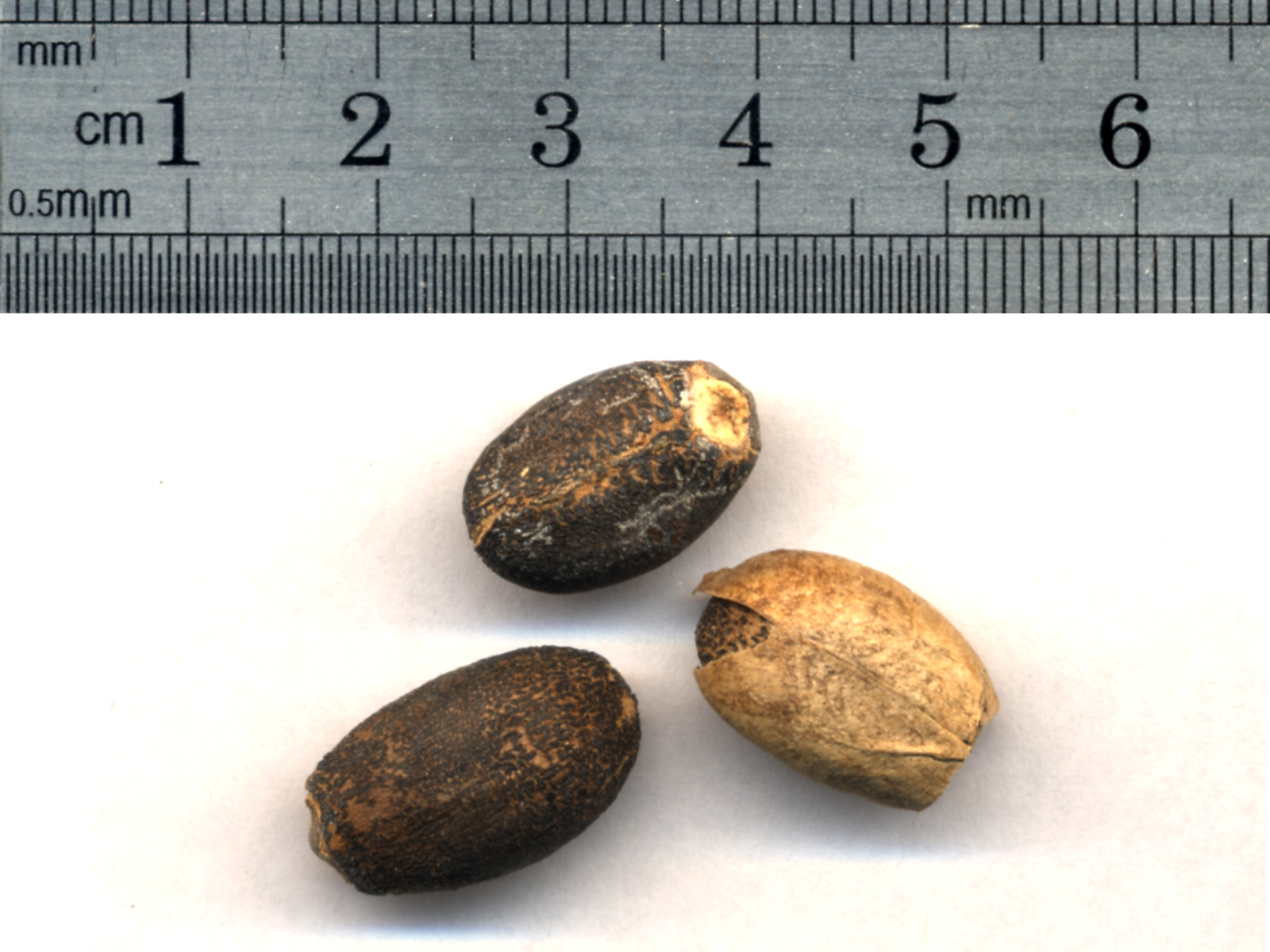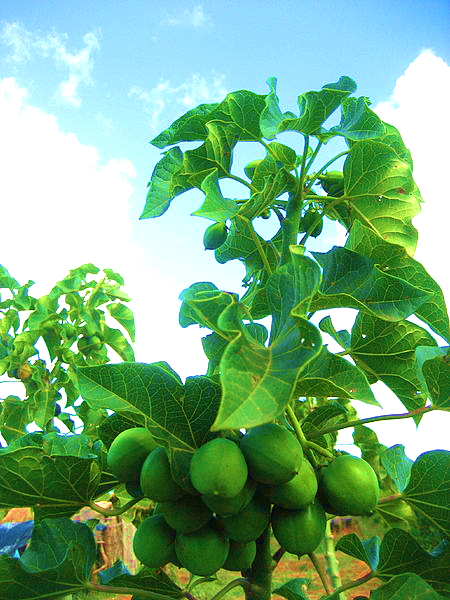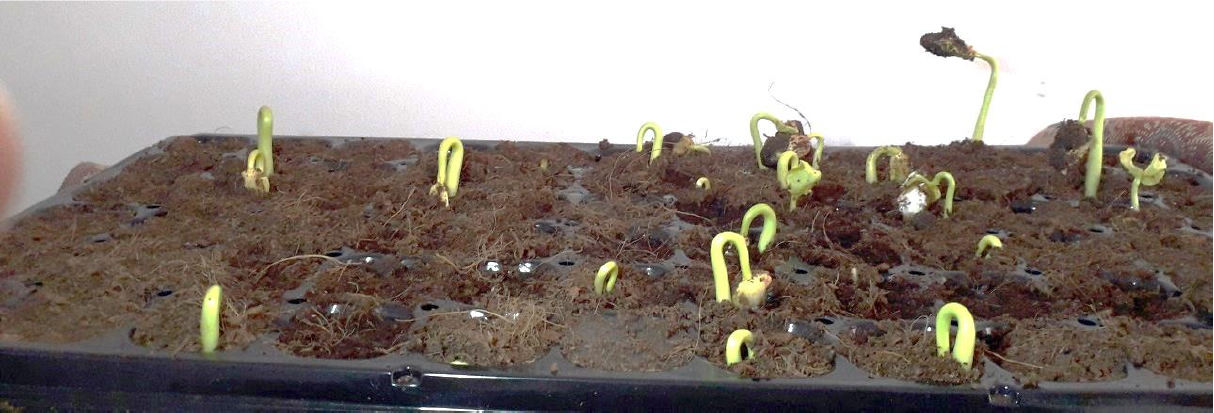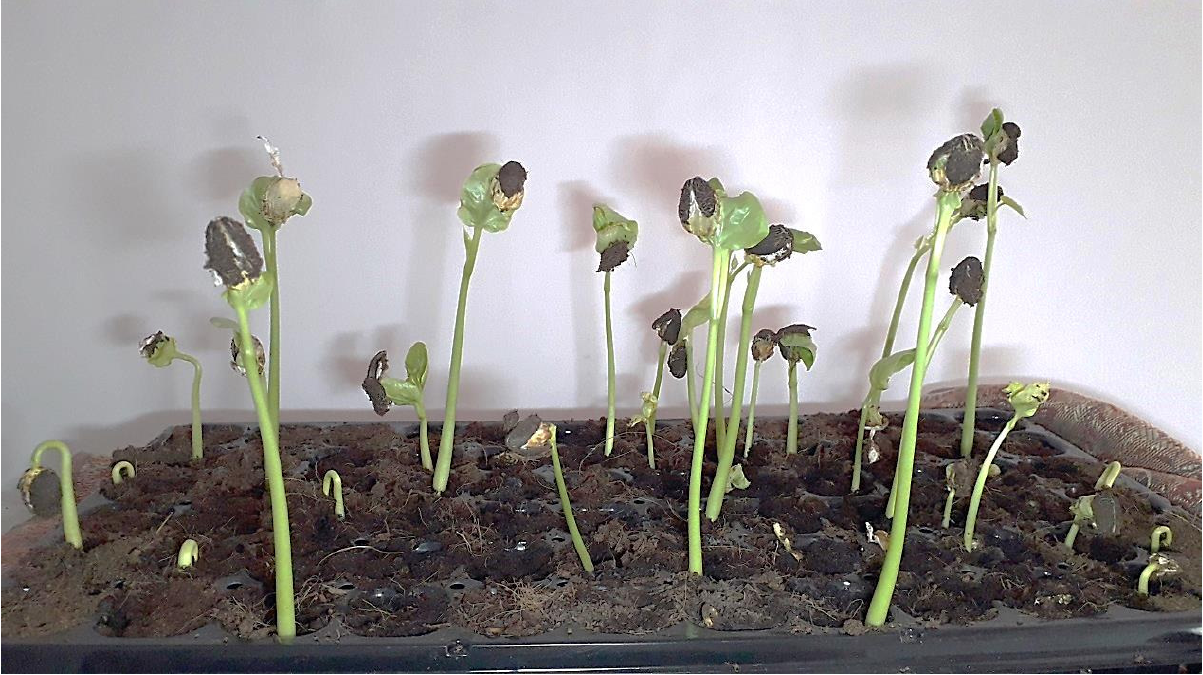2020 Volume 8 Pages 109-123
2020 Volume 8 Pages 109-123
The present article can be regarded as a compilation of various aspects related to the cultivation and utilization of Jatropha curcas in degraded lands, which may not be very suitable for other crops. The benefits of this plant are not limited to producing biodiesel, but expand to biogas and biobriquettes. So, all three phases of fuel (liquid, gas, solid) are possible outcomes from it. Aside from fuels, the byproduct seedcake resulting from pressing the seeds can be used as a good organic fertilizer that is comparable or even better than chicken manure. After detoxification, this seedcake can be valuable feed for livestock. Along with the positive expectations, the study is balanced by also addressing negative expectations when planting Jatropha curcas for commercial applications. A seeds sample of this plant was successfully germinated in indoor condition, after applying the shell cracking pre-treatment. Special attention is paid to the Sultanate of Oman as a country whose geographic location and vast desert lands may encourage large-scale investment in Jatropha curcas for boosting and diversifying the economy.
The Sultanate of Oman (or simply Oman) is an Arab Gulf country in South West Asia. It is one of the six Gulf Cooperation Council (GCC) countries, along with the Kingdom of Saudi Arabia (a neighbor), the United Arab Emirates (a neighbor), the Kingdom of Bahrain, the State of Kuwait, and the State of Qatar. The size of Oman is 309,500 km2. The majority (82%) of this geographic space is desert areas. Mountains come next, with a share of 15%. The population (classified as 56% citizens and 44% expatriates) is concentrated on a coastal strip representing 3% of the total surface area of the country (Omani Supreme Council for Planning, 2019).
Putting the country area into perspective, it is 0.87 the area of Germany 357,580 km2, 1.27 the area of the United Kingdom 243,610 km2, 0.56 the area of France 549,087 km2, and almost the same area of Italy 301,340 km2 (World Health Organization, 2020). Compared to its two neighbor GCC countries, Oman’s area is 0.255 the area of Saudi Arabia 2,149,690 km2 (Abdulai and Shamshiry, 2014), and 6.57 the area of the United Arab Emirates 83,600 km2 (International Business Publications, 2018).
Moving to the economic status, the 2018 gross domestic product (GDP) per capita in current U.S. dollars of Oman is US$ 16,415 (The World Bank Group, 2020). Back to the six comparison countries, the 2018 GDP per capita of Germany is US$ 47,616 (2.90 times of Oman), United Kingdom is US$ 42,962 (2.62 times of Oman), France is US$ 41,470 (2.53 times of Oman), Italy is US$ 34,489 (2.10 times of Oman), Saudi Arabia is US$ 23,339 (1.42 times of Oman), and United Arab Emirates is US$ 43,005 (2.62 times of Oman). Like several Middle East countries, Oman relies heavily on its oil and gas sector (EIA, 2019). About half (51%) of the GDP of Oman is from oil and natural gas extraction. This is the largest contributing sector to the GDP. The second contributing sector is the services sector, representing 37% of the country’s wealth. Under the services sector, the most important segments are: wholesale and retail trade (8% of GDP), public administration and defense (7% of GDP), and transport, storage and communication (6.8% of GDP). Other sectors have less significant roles in GDP, where manufacturing and mining contribute with 6%, construction and electricity and water distribution contribute with 5%, and agriculture contributes for the remaining 1% (TRADING ECONOMICS, 2020).
The latest (9th) edition of the country's 5-Year National Development Plan (2016-2020), was formulated in the context of low oil prices that declined after mid 2014 (Supreme Council of Planning, 2016). The plan aims to diversify the national economy by pushing up non-oil revenues. While the oil and gas sector remain the prime mover of the economy as per the plan (the energy sector was merged into that sector in the plan), five diversification sectors are considered: manufacturing, transport and logistics, tourism, fisheries, and mining. It is noted that the agricultural sector is not among these diversification sectors. The plan realizes the fluctuations of oil prices, the demographic change in the society (increase of the youth proportion), and the gap between the public expenditure and the revenues as three challenges to which it responds.
Aside from the 5-Year National Development Plan, there is a national program for the future vision (Oman 2020 or Vision 2020) that encourages the shift to a sustainable and diversified economy, with a main goal to ensure that the per capita income does not go below its 1995 level, but attempting to double it by 2020 (Supreme Council of Planning, 2020). A subsequent future program (Oman Vision 2040) was launched recently, with the theme being joining the World’s developed countries, through 10 indicators, including the GDP per capita, GDP growth, and the non-oil share of GDP (Oman Vision 2040, 2019).
Limitations on renewable water resources along with unpredictable rain pattern (Kwarteng et al., 2009; Directorate General of Meteorology, 2016; Food and Agriculture Organization, 2020a), low fertile land, and high atmospheric temperatures pose challenges for agriculture development in the Sultanate of Oman. A similar situation exists in other GCC countries, which results in a small contribution of the agriculture sector to GDP (Shahid and Al-Shankiti, 2013). Oman has a long coastline of about 3,165 km, divided over three bodies of saline water: the Arabian (Persian) Gulf, the Gulf of Oman, and the Arabian Sea Food and Agriculture Organization, 2008). Oman has ample non mountain surface lands, access to saline water, and sunny days most of the year with high solar insolation; three resources that may be utilized to achieve environmental, industrial, economical, and societal gains at the national level.
This work calls for utilizing the vast undeveloped lands in the Sultanate of Oman or a country with similar climatic conditions and environmental resources. The core of the idea is cultivating a non-native crop that can tolerate lands of poor quality not suitable for ordinary farming, moderately saline water, as well as hot dry sunny climate while yielding a produce that can be converted into tradeable products, mainly: biofuels, fertilizers, and animal feed. The concept presented here is given the term MLD, which stands for marginal land development. The development does not just have an agricultural facet, but also environmental, industrial, economical, and societal ones. While the focus here is given to the Sultanate of Oman, the concept is applicable to any country or region having a similar situation of limited fresh water and arable lands, but has near-plane lands (like open deserts) and hot dry climate.
It is hoped that Jatropha curcas becomes a core of a governmental-sponsored program for increasing the contribution of the non-oil sector in the Sultanate economy, establishing large new industrial segments, providing jobs, forming small-to-medium enterprises (SMEs) in the private sector, attracting foreign investments, building a database of skills and experience in the field of sustainability and marginal land development, and reducing environmental pollution through the replacement of fossil fuels with biofuels.
Jatropha curcas (to be called simply Jatropha in this work) is a perennial tree that tolerates drought and can grow well in marginal soils. It lives for about 50 years, and after 3 years produces non-edible seeds. The kernel of the seed can be pressed to give combustible oil that can be used as a fuel on its own without extra processing. Jatropha oil burns without smoke. Jatropha is a rugged plant, which can survive with minimum inputs (Jain, 2019). Jatropha oil can be a sustainable substitute of kerosene (Chhetri et al., 2008).
Jatropha seeds are toxic (Devappa et al., 2010). The plant as a whole is poisonous, but the seeds are very poisonous. Consuming Jatropha seeds can lead to burning sensation in the throat, abdominal pain, vomiting, and diarrhea (Singh et al., 2010). Figure 1 shows three seeds of Jatropha, demonstrating their size in centimeters. The size of the seed is near the size of a kidney bean.
Although Jatropha tree can give its first yield after 3 years of cultivation, one may need to wait 5 years to get a yield suitable for biodiesel production that pays back the expenses. This is a major obstacle in adopting a large-scale commercial program for Jatropha cultivation (Lahiry, 2018).

Fig.1 Jatropha fruits with their size demonstrated.
Credits: Emoc (assumed, based on copyright claims).
Image license: CC BY-SA 2.5.
Source: https://commons.wikimedia.org/wiki/File:Seed_jatropha_curcas.jpg
Using a cylinder-hole oil press (an expeller) with a twin-screw rotating core, it is possible to extract about 90% of the oil content of the seed, by weight. However, this is an upper limit, while a value of 80% seems to be a better practical average (Siregar et al., 2015). This percentage is called the oil extraction efficiency. The byproduct (coproduct) of the seed pressing is called the cake or the seedcake. It still has some oil content not captured by the press. It can be assumed on average that the seed has 40% shell and 60% kernel, by weight, and 35% of the kernel is oil content, by weight (Carels et al., 2012; Cañadas-López et al., 3 2018).
The Jatropha plant is native to tropical southeastern Mexico (Rincón-Rabanales et al., 2016). Other names for the plant are “physic nut” and “purging nut” (Ahmad and Sultan, 2015). Its tree matures at the age of 8 years or more, reaching a height of 7-13 m. The fruit takes about 90 days to reach its full size. It passes over three stages distinguished by the outer color. The first one is 30-45 days of green color, followed by 45-60 days of yellow color, and finally 60-90 days of brown color. The fruit carries 2-3 seeds; each seed has a shell and a kernel. The oil content of the kernel ranges between 32% and 40%, by weight. Jatropha can be propagated by seeds (directly planted in the field), but this is expected to give a low survival rate below 50%. Thus, one needs to sow extra seeds at each sowing pit. It is preferred to first sow the seeds in nursery beds to increase the germination rate and provide controlled environment for the seedlings. Cuttings are also possible for vegetative propagation, and this method is preferred because of genetic uniformity, rapid establishment, less waiting time before getting the yield, and increased rate of plant survival. While direct field seeding can give a survival rate below 50%, raising the plants in a nursery from seeds and cuttings, and direct planting of cuttings were found to have a better survival rate exceeding 80%. Tissue culture is limited to research work. There are two times for transplanting the seedlings of Jatropha into the field, March and October (Heller, 1996; Abobatta, 2019). Field preparation requires a cubic pit with a side length of about 0.5 m. The spacing between these pits can be 2.5 m (between pits in the same row) and 2.5 m (between parallel rows of pits). With this tree density, one feddan of 4,200 m2 accommodates 672 trees. It is possible to increase the row spacing to 3 m, which drops the tree density to 560 trees per feddan. The feddan is a unit of measure for lands used in some Middle East countries, like Oman and Egypt (The World Bank, 2001; Directorate General of Agriculture & Livestock Research, 2012). It is a little larger than the acre 4,047 m2. Jatropha shows fast growth until the month of October. It sheds its leaves during the summer or fall (autumn) season and remains in a state of dormancy in the winter season that ends in the month of February. It is possible for Jatropha to produce fruits two times in a year; the first is in June while the other is in late December. Jatropha trees may also bear fruits continuously from the middle of the summer to near the end of the fall (autumn). Reported total yield of seeds from mature trees ranged from 84 kg to 5,040 kg per feddan, depending on the environment and genotype (Tomar et al., 2014; Nahar and Ozores Hampton, 2017; Abobatta, 2019). This can be an unfavorable concern when growing Jatropha commercially, which is the possible high variability of the plant produce. The terminal inflorescences of the Jatropha plant have greenish yellow unisexual flowers that are dominantly male (2-19 female, 17-105 male). The female-to-male flowers ratio varies from 13:1 to 29:1 (Kumar and Tewari, 2015). Figure 2 shows a cluster of Jatropha fruits while still in the green-color stage.

Fig.2 Jatropha fruits born by a Jatropha tree. Credits: Ton Rulkens from Mozambique.
Image license: CC BY-SA 2.0. Source: 4
https://commons.wikimedia.org/wiki/File:Jatropha_curcas_7_(4324563835).jpg.
Contrast and/or brightness altered from the original for better clarity.
Jatropha requires tropical or sub-tropical regions temperatures. The cultivation longitude limits are 30° N and 35° S. Jatropha needs enough sunshine, and it does not grow well under shade (Ye et al., 2009). The tree is succulent, having deep roots that suit semi-arid conditions (Brittaine and Lutaladio, 2010). The water need of the plant can be fulfilled by a minimum of 800 mm/year of rain. Otherwise, an irrigation system would be needed. Moist soils are not good for Jatropha. While the plant tolerate drought, too heavy rain in the excess of 4,000 mm/year can be a problem. Good drainage or run off is needed for a rain rate in the range of 800-4,000 mm/year. Excessive rain is expected to cause fungal attack and retard the growth of the roots, unless the soil is highly well-draining. Some trials showed a lot of disparity among individual plants (with three orders of magnitude difference). This means unpredictable production. This issue may be mitigated by careful plant selection (Jatropha. Pro, 2019). The Omani and GCC climate fit this plant. Oman has a hot climate, with the temperature reaching 40 °C during June in the Capital of Muscat, located on the Gulf of Oman. With inland wind, the temperature can rise to 50 °C. In the winter, the average temperature drops to between 18 °C and 26 °C (Oman e-Visa Travel Authorization Agency, 2020). In Muscat, the average high/low temperature is about 21/30 °C in March and 25/35 °C in October (Weather Atlas, 2020).
Jatropha can be intercropped with other crops (Rao et al., 2017). Although intercropping enables getting revenues in the first years of the Jatropha life, it can increase the abundance and diversity of mite pests (Cañarte et al., 2020) and also pose difficulty in irrigation control to meet the needs of each plant properly despite sharing the same soil and its moisture content.
In terms of weed control, a dedicated study (Concenço et al., 2014) on this topic reported that areas with low soil coverage showed relatively high levels of weed infestation when crops are intercropped with Jatropha. It also found that crop rotation in the interrows of Jatropha was accompanied by a remarkable decrease in weed infestation.
As far as salt tolerance in irrigation water (in case rain is not to be used to fulfill the plants need), Jatropha seedlings were found to tolerate a molarity of sodium chloride (NaCl) up to 60 mM, which is about 3,500 ppm (parts per million, by weight) before a salt-induced decline in the total biomass was well observed. Therefore, Jatropha is moderately salt-tolerant (Díaz López et al., 2012). Its tolerance is comparable to date palm trees (Khan and Prathapar, 2012), which are common and known in Oman and GCC. After Jatropha was subjected to mild salt stresses, it then showed fast recovery (Silva et al., 2010). Jatropha cannot make direct use of the plenty sea water at the coast of Oman. However, it does not require full desalination to the level of potable water, like 500 ppm of total dissolved solids, including salts (NSF International, 2020). It also can utilize saline underground water that is not suitable for other less tolerant crops.
Regarding the germination of Jatropha seed, healthy Jatropha are expected to germinate in 10 days after sowing in soil (Jatropha.Pro, 2020). When selecting seeds for sowing, a so-called floatation test may be performed. In that test, seeds are put in water. Those which submerge and do not float are rejected, because they are not useful for planting (Amonum et al., 2019). Four pre-sowing treatments were analyzed in terms of their impact on germination: soaking in 30 °C water for 24 hours, manual shell cracking, warm stratification (seeds mixed with peat, as a moist medium, with 1:1 volume ratio in a close container) at 37 °C for 24 hours, and manual shell cracking coupled with stratification at 37 °C for 24 hours. Shell cracking was found to improve germination. Seeds can be sown at a depth of 1 cm (Marcello et al., 2015).
We here describe our own experience in germinating Jatropha seeds. This was done at Al Buraimi Governate, in the Sultanate of Oman. This part of the country is relatively dry, located far from any large body of water. Almost none of the seeds failed the floatation test.
Figure 3 illustrates the process of manual shell cracking using a pliers tool. Figure 4 shows some seedlings forming in a seedlings bed. It is noted that there is a disparity in the days taken for germination. Pure organic potting mix was used. Germination took place indoors, away from natural sunlight, with office-type illumination and near full darkness at night. Not all seeds germinated. Figure 5 shows the plantlets after nearly one additional week.

Fig. 3 Shell cracking of one Jatropha seed (own work, not published before)

Fig. 4 Germination of Jatropha seeds in a plastic seedlings bed, about 2 weeks after 2 sowing
(own work, not published before)

Fig. 5 Jatropha plantlets, about 3 weeks after sowing
(own work, not published before)
The harvesting of the Jatropha fruits (which contain the seeds, which in turn contain the oil bearing kernels) can be performed manually, semi-manually, and fully-mechanically. Manual collection of the fruits can be viewed as suitable for small farms. The fruits are either picked by hands or collected using rods to reach those too far to be gasped directly. Manual harvesting offers the advantage of high selectivity, so only ripe fruits are harvested. However, given its low speed and high effort, it may not be efficient for large farms. Semi-mechanical harvesting uses electrically operated or gasoline operated (petrol operated) implements carried by a human operator, which induce vibration in the branches or directly strike the fruit. It is a compromise between slow manual harvesting and expensive harvesting machines. This technique is used for other crops, like apricot and olive (Gruppo P.A.N.A.C.E.A, 2020).
Fully mechanized harvesting involves the use of a motorized mobile harvesting vehicle, such as the Korvan 9240 mechanical jatropha harvester (Oxbo, 2020). This fully mechanical harvesting mode offers the advantage of high harvesting rate of about 0.5 to 1 ha/h (hectares per hour), depending on the exact machine model, although the machine forms a big capital cost. The tree spacing should be wide enough in the case of mechanized harvesting. Fully mechanized harvesting may mistakenly harvest immature fruits and cause damage to flowers still on the plant. Pruning can facilitate harvesting by limiting the trees height to 2 m (Nahar and Ozores-Hampton, 2017).
Jatropha oil can be chemically processed in a process called transesterification to convert it into biodiesel (Raja et al., 2011; Folaranmi, 2013). In simple terms, transesterification is converting an input ester (which is vegetable oil or animal fat, triglycerides) to an output ester (which is the biodiesel) using a catalyst (such as sodium hydroxide). Along with the input oil, an alcohol (especially methanol) is the other reactant. Along with the output biodiesel, glycerol (also called glycerin) is the other product. When the reactant alcohol is methanol, the product biodiesel is referred to as fatty acid methyl ester, or FAME (European Technology and Innovation Platform Bioenergy, 2019). A comparison between fossil (also called mineral) diesel and Jatropha oil is provided in Table 1 (Hanumantha Rao et al., 2009). The flash point is the minimum temperature at which a vapor given off from a combustible liquid is capable of igniting in case it meets a suitable source of heat (like a flame or a spark). The flash point is related to the volatility of the liquid (Ellis, 1972).
| Property | Calorific value (MJ/kg) |
Density (kg/m3) |
Kinematic viscosity at 40 ºC | Flash point (ºC) |
| Fossil/Mineral diesel |
45.3 | 840 ± 1.732 | 2.44 ± 0.27 | 71 ± 3 |
| Jatropha oil | 39.1 | 971 ± 1 | 35.98 ± 1.3 | 229 ± 4 |
While the energy contents per weight and the densities are not largely different between fossil diesel and Jatropha oil, the viscosity and flash point are very dissimilar. Jatropha oil is more viscous and less volatile than diesel. The produced biodiesel from Jatropha oil may be mixed with fossil diesel or used as it is without blending as a substitute for fossil diesel. In the latter case, it is described as B100 biofuel.
While pure Jatropha oil can successfully run a simple diesel engine, this can be regarded as a test operation rather than an endured operation. Using straight vegetable oils (SVOs) without blending or preheating in a diesel engine (either for transportation, power generation, or powering machines) can cause performance problems over time, such as carbon deposits on parts of the engine (Sidibé et al., 2010; Shah and Ganesh, 2018). A blend of 80% fossil diesel and 20% Jatropha oil (which is described as a J20 grade) was found to give similar combustion performance and emissions to those corresponding to using pure fossil diesel. In addition, it was found that that the high viscosity of vegetable oils is not essentially responsible cause of degraded combustion performance in a diesel engine, which leads to carbon deposits (unburned matter due to incomplete combustion) in the combustion chamber (Sidibé et al., 2020).
Jatropha cake has an energy content of about 5 kWh/kg (18 MJ/kg). It can be compressed further as briquettes biofuels instead of firewood causing deforestation, as well as used as a feedstock for biogas production. Both uses are achievable, cost-competitive, and considered environmental gains.
Moreover, the residue from the biogas production or the ash from industrially burning the biobriquettes (e.g., in a brick kiln or in a combined heat and power plant) can be used as a natural sustainable fertilizer. The cake acts as a fertilizer and mulch, helping in the reduction of moisture loss in addition to building up soil structure. It should be mentioned that residual oil left in the cake may help in reducing nematode attack on the roots (Lang and Elhaj, 2013).
When used alone as an organic fertilizer for tomatoes, Jatropha cake outperformed chicken manure and livestock manure, in terms of the yield for a given land area. Best yield was observed when a mix of the cake and the chicken manure was used (Mambo et al., 2018). While the cake or kernel meal, as byproducts of the Jatropha oil extraction process, are not usable as animal feed because of toxicity (have significant amount of phorbol esters), detoxification makes them valuable sources of animal feed (Food and Agriculture Organization, 2020b). The seedcake of Jatropha is used in Tanzania as fertilizer, animal feed, and a feedstock for producing biogas as a source of energy. The nutrient value of the cake is better than of cow dung, and can be compared to chicken manure. The cake contains microelements nitrogen (N), potassium (K), phosphorus (P), and sulphur (S). The cake contains micronutrients zinc (Zn), iron (Fe), copper (Cu), and manganese (Mn). The nitrogen content in the cake is up to 6%, which is on a par with the content in chicken manure (Mkoma and Mabiki, 2011).
Despite the seemingly-promising features of Jatropha, and the multiple benefits it may provide, investing in this tolerant plant has its challenges. While a lot of grant money was released by several projects for large-scale plantation of it (at the level of millions of feddans), the progress does not seem remarkable. Some of the obstacles for exploiting Jatropha commercially include (Kripal et al, 2014; Moniruzzaman et al., 2017)
The low yield in the case of Jatropha is linked to the very small female-to-male flower ratio (1:29-1:13), which depends on the genotype (Ahmad and Sultan, 2015). Investment in Jatropha is relatively new worldwide. Thus, there is a lot of experience base to be gained, which hopefully can help deal with the challenges associated with this plant. A recent study (Antwi-Bediako et al., 2019) examined six major Jatropha investment cases worldwide in Mexico, India, China, Ethiopia, Mozambique, and Ghana. It suggests that the negative outcomes were due to following a trial-and-error approach accompanied by optimistic expectation. Investment in Jatropha by no means is just planting the trees and harvesting the fruits. The process extends to transforming the fruits into products that have a demand market while not exceeding in cost the traditional alternatives. Jatropha biofuel has proved to serve successfully in airliners (Biello, 2008; The Hindu Business Line, 2018; Philip, 2019). The future of Jatropha utilization as a feedstock for biofuel or other uses seems complex to predict, being influenced by factors such as governmental support, scientific development of better-yield genotypes, regulations on fossil fuel and their blending with biofuels, social awareness, and responsibility level toward the environment (Kennedy, 2017). Perhaps more time is needed to see economically sustainable projects, in case of favorable progress happens.
With raised concerns about negative environmental impacts due to using fossil (mineral) fuels, biofuels may be an attractive sustainable alternative provided that they can technically and economically compete with the fossil ones. While biofuels still emit the greenhouse gas carbon dioxide (CO2), this emission is part of the ecological carbon cycle. No matter how much carbon dioxide is emitted from biofuels, it is not considered a source of pollution and ecological disorder.
Using edible oil as feedstock for biodiesel may cause a social problem by increasing food prices. Instead, using a non-edible plant that can be planted in degraded lands not otherwise utilized is an excellent route for biofuel generation, provided that the production and conversion is economically and technically viable. Jatropha curcas is a prospective candidate for such task.
The vegetable oil plant (Jatropha curcas) has received attention recently as a promising sustainable source of biodiesel. Whereas other vegetable oil plants can provide the feedstock for biodiesel, Jatropha curcas had the advantage that it can be planted on degraded lands and it tolerates harsh environments. Also, the plant seeds are not edible, so there is no competition in its use between the food sector and fuel sector. The plant is mildly tolerant to water salinity, and can accept up to about 3,500 ppm of dissolved salts in irrigation water. A rate of rain at 800 mm/year fulfills the water need of the plant.
Different data about this plant, its favored climate, propagation options, possible uses, tolerance to salinity, and challenges are discussed. The work is not a full proposal, but rather provides a generic picture taken from multiple references and arranged in a single article. The core part on Jatropha is divided into 10 sections (out of 12 total sections in the article). Each section addresses a topic related to Jatropha planting or usage. An interested reader may then decide whether or not to proceed further and read deeper about the one or more of the topics presented here.
For the Sultanate of Oman, this plant may be worthy of exploitation, in alignment with the country’s 2020 and 2040 Visions, and Five-Year Development Plan 2016-2020 that aim for diversified and sustainable economy. Some characteristics of the Sultanate were compared to six countries (the four top-GDP European countries and the two GCC neighbor countries). Such comparisons suggest that the Sultanate has huge natural resources to utilize in terms of marginal lands, and Jatropha curcas may be a key element in this effort. Marginal land development is not limited to the planting of Jatropha curcas, but extends to establishing dependent manufacturing and trade facilities on this land, leading to sustained communities.